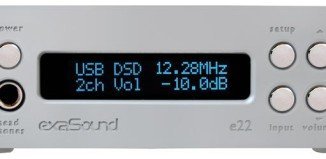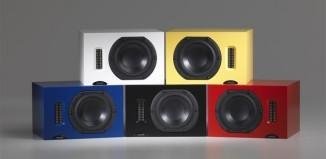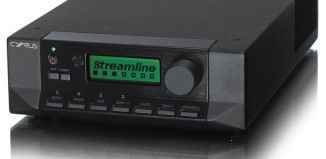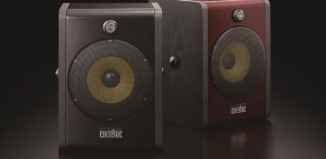
The launch of the Blu-ray high definition disc format didn’t exactly live up to its hype. The first Blu-ray player on the market didn’t perform as well as everyone had hoped for and the initial waves of poorly produced Blu-ray movies certainly didn’t help. The launch of the Panasonic DMP-BD10 Blu-ray player was highly anticipated because it could turn things around for the Blu-ray format. Early this October, the Panasonic player spent seven days in my home theatre. Aside from evaluating its performance, I also had the opportunity to compare it to my Toshiba HD DVD player.
The DMP-BD10 has a simple, clean design. Its entire front panel is covered by a glossy black door behind which a handful of DVD navigation buttons are found. The rear panel of the player offers HDMI, component, S-video and composite video outputs. The highest video resolution, 1080p, is delivered only through the player’s HDMI output. Audio is available through HDMI, 7.1 analogue jacks, optical, coaxial and 2 channel analogue jacks. The DMP-BD10 is capable of playing formats including Blu-ray, DVD-Video, DVD-Audio, CD, mp3, jpeg, Video CD and SVCD. A useless composite video cable is included in the box but an HDMI cable is not supplied. At this price point, I was expecting to see a good quality HDMI cable.
The supplied remote is large and felt somewhat awkward in my hand. I couldn’t find the player’s setup menu on the remote until I looked it up in the manual - it should never be this difficult. It turned out that the top half of the remote flips open to expose other buttons behind it, one of which is the setup button. With the flap open, the remote looks more like Jean Luc Picard’s tricorder than a remote. The elderly might enjoy the large buttons of the remote, although this isn’t exactly the target audience for Blu-ray - is it? All-in-all, this is just a bad remote.
I had the Panasonic DMP-BD10 connected to a Pioneer PDP-4360HD plasma and a Pioneer Elite VSX-84TXSi A/V receiver. Sound was delivered through my Sinclair Audio Brighton Series speakers. Since my 720p Pioneer plasma does not accept the 1080p signal, I was only able to test 720p and 1080i signals.
Slow start-up and loading times of the first Blu-ray and HD DVD players got a lot of criticism but the Panasonic wasn’t exactly quick itself. It took about 16 seconds for the player to power on and open the disc tray. It took another 20 seconds for a Blu-ray disc to begin playing. I also noticed that skipping forward through chapters of a Blu-ray dics was slightly slower than with a regular DVD. Skipping backwards through chapters was annoyingly slow.
To perform my video evaluation, I used two Blu-ray movies: Stealth and Kiss Kiss Bang Bang. The picture of Stealth, encoded using the MPEG2 codec, looked spectacular. The details and the high resolution of the picture were particularly noticeable during the slower scenes. In one of the chapters, I could clearly distinguish between individual trees covering a mountain far in the background of the picture. On a regular DVD, the trees would have simply blended into a green blanket of trees in the background. During another scene, an engineer was sifting through a bundle of tiny wires and again I could see each individual wire. Kiss Kiss Bang Bang was encoded using the newer codec VC-1 and its picture looked ever so slightly better. While watching Stealth, I noticed a few picture artifacts but I didn’t notice any at all with Kiss Kiss Bang Bang. The details and imperfections in the actors’ faces were astonishing, making the characters look much more real than a standard DVD is capable of doing. The colours produced by the Panasonic player were natural out of the box but users who enjoy tweaking video will enjoy the extensive picture controls that this player offers. Buttons for contrast, brightness, sharpness, colour, gamma, noise reduction and re-mastering are hidden behind the flap on the remote. The “pop-up” menus of both movies that I watched were nice although nothing to brag about compared to regular DVDs. For picture performance when viewing Blu-ray material, I give the Panasonic a full 10 out of 10.
The big question of course is, how did the high definition picture quality compare to my Toshiba HD-A1 HD DVD player? After countless times of switching between Blu-ray and HD DVD discs, I came to a conclusion that both HD pictures looked just as spectacular. In the end, it boils down to how well the movie was transferred to the high definition disc.
Watching a few chapters from Star Wars III: Revenge of the Sith and Gladiator had me convinced that the video up-conversion of the Panasonic player was also quite impressive through its HDMI output. The exterior panels of the starships that had a slightly soft appearance in 480p were now sharper and showed extra details. The faces of the characters were better defined and showed finer details. The nice thing is that with the up-conversion enabled, everything looked as natural as it did with it turned off (some up-converting DVD players produce somewhat unnatural results).
To evaluate the Panasonic’s audio performance, I used two different audio output options (one at a time of course): optical and 7.1-channel analogue. Using the optical connection, the Dolby Digital performance was that of a good quality DVD player - no surprises here. Switching to uncompressed PCM audio through the player’s analogue 7.1 outputs made quite a difference though. The sound field became a lot more spacious and enveloping. Low frequencies were more defined and different bass notes became easier to distinguish. Mid and high frequencies became crisper - I could suddenly hear a lot more details in the soundtrack.
The DMP-BD10 does not currently decode DTS-HD and Dolby TrueHD lossless soundtracks but Panasonic promises a future firmware upgrade that will enable it to decode both formats. This will certainly be a treat to look out for.
The DVD-Audio performance of the Panasonic was also great through both the HDMI and 7.1 analogue outputs. I listened to a selection of tracks from The Latin Jazz Trio, Blue Man Group Audio and Foo Fighters One by One. The instruments sounded very clean and the soundstage was spacious in every song that I listened to. Something that surprised me about the Panasonic is that its display does not show the track number (or for that matter the DVD chapter) while it’s playing a disc. This is very inconvenient, especially when listening to DVD-Audio discs with the display turned off.
The Panasonic DMP-BD10 Blu-ray player delivered phenomenal picture and sound quality, there is no question about it. This player undeniably proved to me the potential of the Blu-ray format. Spending $1500 on this player is questionable given that it’s difficult to say right now how the high definition disc format war will pan out. However, by all means if you want to watch the highest quality video available today and have the money, go pick up the Panasonic DMP-BD10 because overall it’s a fantastic high definition player.
Manufacturer:
Panasonic
www.panasonic.ca
Price:
$1499 (Canadian)
Panasonic DMP-BD10 Blu-ray Disc Player
• Plays: Blu-ray discs, DVD-Video, DVD-Audio, CD, mp3, jpeg, video CD and SVCD
• Advanced I/P conversion with P4HD (Pixel Precision Progressive Processing for HD)
• 1080p up-conversion for standard DVDs through HDMI
• 192-kHz/24-bit Audio DAC
• Video outputs: HDMI x 1, component x 1, S-video x 1, composite x 1
• Audio outputs: 7.1-channel analogue, HDMI x 1, optical x 1, coaxial x 1, 2-channel analogue stereo
• Remote control type: non backlit
• Dimensions (WxDxH): 430 mm X 331.6 mm X 85 mm
• Weight: 4.7 kg





